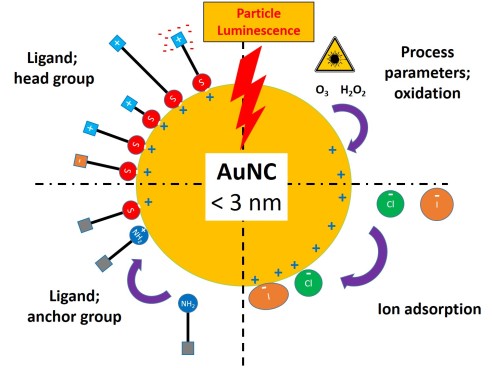When noble metal nanoparticles are reduced in size below 3 nm, they are defined as nanoclusters. In this case plasmonic properties cease, while on the other hand photoluminescence emerges, due to the formation of discrete energy levels. The mechanism of this fluorescence is to date not fully understood, predominantly because in chemistry nanoclusters can only be synthesized in the presence of organic ligands. Therefore, our group focuses on the generation of noble metal nanoclusters by pulsed laser fragmentation in liquids without the use of organic ligands.

Our main research goals and interests are:
- The process of pulsed laser fragmentation and how it may influence nanocluster size distribution and yield
- Understanding the origin of the fluorescence in these ligand-free nanoclusters and to what extent it is linked to particle size, oxidation state and surface chemistry
- What is the role of organic ligand and how does it alter the fluorescence properties
- Utilization of ligand-free nanoclusters in bioimaging
References:
[1] Ziefuss, A. R.; Willeke, M.; Miertz, M.; Heinemann, A.; Rehbock, C.; Barcikowski, S. Influence of Pt Alloying on the Fluorescence of Fully Inorganic, Colloidal Gold Nanoclusters. Chemphyschem (2022), 23.
[2] Ziefuss, A. R.; Steenbock, T.; Benner, D.; Plech, A.; Gottlicher, J.; Teubner, M.; Grimm-Lebsanft, B.; Rehbock, C.; Comby-Zerbino, C.; Antoine, R.; Amans, D.; Chakraborty, I.; Bester, G.; Nachev, M.; Sures, B.; Rubhausen, M.; Parak, W. J.; Barcikowski, S. Photoluminescence of Fully Inorganic Colloidal Gold Nanocluster and Their Manipulation Using Surface Charge Effects. Advanced Materials (2021) 33.
[3] A.R. Ziefuss, S. Barcikowski, C. Rehbock, Synergism between Specific Halide Anions and pH-Effects during Nanosecond Laser Fragmentation of Ligand-Free Gold Nanoparticles, Langmuir, 35 (2019) 6630-6639
[4] A.R. Ziefuss, S. Reichenberger, C. Rehbock, I. Chakraborty, M. Gharib, W.J. Parak, S. Barcikowski, Laser Fragmentation of Colloidal Gold Nanoparticles with High-Intensity Nanosecond Pulses is Driven by Single-Step Fragmentation Mechansim with Defined Educt Particle-Size Thrshold, Journal of Physical Chemistry C, 122 (2018) 22125-22136
[5] M. Lau, I. Haxhiaj, P. Wagener, R. Intartaglia, F. Brandi, J. Nakamura, S. Barcikowski, Ligand-free gold atom clusters adsorbed on graphene nano sheets generated by oxidative laser fragmentation in water, Chem Phys Lett, 610 (2014) 256-260.

